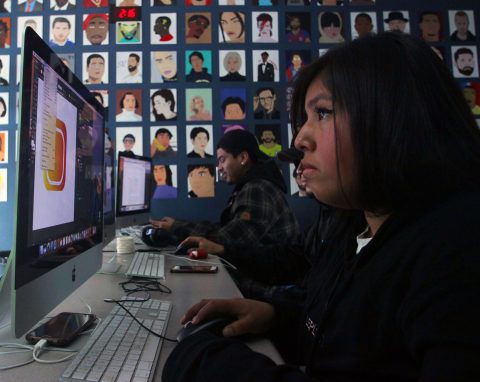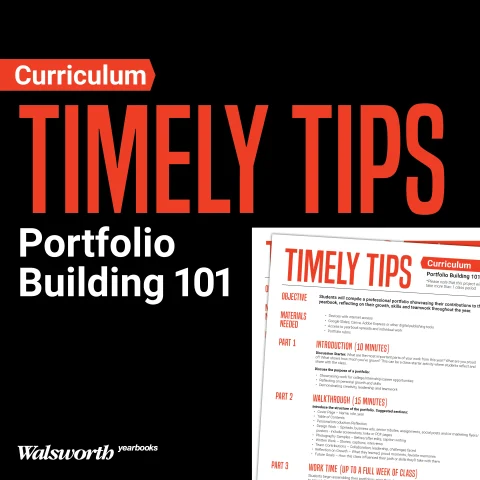Jumping into work on yearbook is exhilarating, exhausting, fun and maybe even a little confusing. What are all these words, phrases and acronyms you’re hearing, such as colophon, folio and CMYK? We’re here to help! Use this handy list to learn commonly used yearbook terms and avoid confusion when talking to fellow yearbookers or your yearbook company.
Black and white: Items in a single color (black) as opposed to full color
Bleed: Extension of images, graphics or backgrounds beyond the trim marks on the edges of a page, leaving no white margin
Bleed bars: Bars, usually blue, found at the edges of Walsworth’s templates and Designer Series layouts to help you determine how far to extend a bleeding element off the page. You should always draw bleeding elements to the outside edge of the bleed bar
Body copy: The text of the main story
Book size: Refers to the size of the pages in your yearbook; Walsworth offers three book sizes: 7 (page measurement of 7 3⁄4 inches x 10 1⁄2 inches), 8 (8 1⁄2 x 11) and 9 (9 x 12)
Byline: A line giving credit to the writer, photographer or designer for their story, photo or layout
Candid: An unposed photo showing action
Caption: About three to four sentences that describe a photo; also called a cutline
ABCD Formula: Formula for writing captions – the Attention Getter is a mini headline; Basic Information is the first sentence containing the 5 Ws and H and written in present tense; Complementary Information is additional information not seen in the photo written in past tense; Direct Quote is a quote from someone in the photo
Closing: Page or pages at the end of the yearbook that verbally wraps up the book; contains theme elements
CMYK: Acronym for Cyan, Magenta, Yellow, and Black, the four colors used in printing full color
COB: Cut-out background, a term for when the background is deleted from the main subject of the photo
Colophon: Information placed at the back of the book containing facts about the production of the book such as printer, copies ordered, type and paper specifications and general acknowledgements
Complementary colors: Two colors directly across from one another on a color wheel, such as blue and orange, yellow and purple, red and green
Copy: The words that appear in a book, a newspaper, a website or a printed page
Copy-editing marks: Marks used by editors to explain what changes need to be made to a story; also known as proofreading marks
Copyright: An exclusive legal right to an originator of an item, such as a published work, photo, music or lyrics; copyrighted material cannot be used without permission
Crop:Eliminating unwanted elements in a photo, either using the camera’s viewfinder before the image is shot or using photography software afterward
Cover: The outside of the yearbook
Coverage: Topics featured in the yearbook and how they are covered
Direct quote: Exactly what the person said; appears inside quotation marks
Display fonts: More decorative typefaces usually used for headlines
Divider: Pages in a yearbook that separate one section from another and provide information about the section’s content; also known as division pages or section divider pages
Dominant: A photo or an element that commands the reader’s attention on a spread by size or importance
Double-page spreads (DPS): Two facing pages designed as one unit
Dots per inch (DPI): The number of halftone dots in an inch, used to measure the amount of resolution of a digital image
Drop cap: The first letter of a paragraph enlarged to create a graphic effect
Eyeline: Horizontal line, actual or implied, running across a spread above or below the exact center to create unity
Folio: Page number on a yearbook spread; accompanying words or phrases identifying the content are called folio tabs
Font: A set of letters, numbers, punctuation marks and symbols that share a unified design called a typeface; a group of related typefaces is called a type family
- Body fonts: Typefaces that can be used for body copy and captions; body fonts are usually plainer, less decorative and smaller than display fonts, 12 point or less
- Sans serif: Type without finishing strokes or “feet”
- Serif: Typefaces that have small additional finishing cross strokes placed at the end of the main strokes of a letter
Formula Color: Refers to specific blends of CMYK created by Walsworth that can be used on any four-color page in your book
Gutter: The vertical space between the inside margins of facing pages
Kerning: The amount of horizontal space between two characters
Headline: Type set in larger point size, usually 14 points or higher, and placed above the story to attract the reader’s attention and provide information about a story’s or a spread’s content
Hierarchy: Purposefully directing focus to specific elements before others within a design in order to create an order of importance
Index: An alphabetized list of names and contents that indicates the pages on which each person or item is referenced, usually located in the back of the yearbook
iTags: Plastic tags personalized with names and icons of school sports, activities and interests and placed on books or other possessions; can be used for fundraising
Kerning: The amount of horizontal space between two characters
Ladder: A yearbook blueprint that helps you plan your book by listing the contents of each page
Lead (Lede): First one or few sentences of an article; should grab the reader’s attention, give the story direction and set the tone
Leading: The amount of vertical space between two lines of type
Margins: The white space around the spread; copy and photos must stop at the edge of the margins unless photos bleed off the page
Mugs: Formal student photos with names and other identifying information under them
Namestamping: Imprint of a name and icons on a yearbook cover using hot foil
Nut graf: The paragraph that tells the reader what the story is about and offers background information as needed for clarity; it can be one paragraph or several
Opening: Pages in the yearbook that verbally explain the theme and the theme graphics continue
Packages (Mods): A self-contained package of a pre-determined size, such as a top 10 list, a quiz, a photo cluster, a quote or other stand-alone coverage
Personal ad: Advertisement placed by parents or students rather than businesses
Pica: A printer’s unit of measurement used primarily in typesetting; one pica equals 1/6 of an inch, or 12 points
Pixel: A basic unit of digital imaging; individual dots (pixels) make up the image on the screen
Portraits: Formal student photos with names and other identifying information listed to the side of the row of photos
Process color (CMYK): A color derived by printing overlapping dots of Cyan, Magenta, Yellow and Black; when combined, the eye merges the colors to simulate a single color; thousands of colors can be simulated by mixing percentages of the four process inks
Proof: A hard-copy printout or electronic version of a file used to check what will be printed in your book.
Pull quote: Words from a story that are pulled and printed in a larger point size to create a graphic element; also called pulled quote
Resolution: In digital imaging, refers to the number of pixels or dots that make up an image; an image’s resolution must be high enough to reproduce well on the printed page
RGB: Acronym for Red, Green and Blue, the three colors used in video display, for example, a computer monitor
Signature: A single sheet of paper that, when folded and trimmed, will produce 16 consecutive pages
Spine: Backbone of a book, the narrow portion of a cover between the front and back
Spot color (PMS color): A pre-mixed ink used to add a single color to a page
Spread: Two facing pages designed as one unit; also called double page spread or DPS
Style Guide: A set of established rules governing the production of the book so that design, fonts, colors, copy, theme, etc., will be consistent throughout the book
Subhead: A small headline used to divide copy or a small headline or deck that appears below the main headline; also known as a secondary headline
Supplement: An additional section of the yearbook that is printed separately from the book itself; often printed for spring-delivered books to cover subjects such as spring sports and graduation, which happen after the school’s final deadline
Template: Pages already set up in a design program, either by Walsworth or a staff’s designers, to be modified and saved by designers without affecting the original template
Text: Body copy that tells the story
Theme: Idea or concept threaded throughout a yearbook, unifying its parts
Title page: Page one of the yearbook, containing the title, volume number, year, school name, mailing address, telephone number and school enrollment, or other significant information
Trapped white space: An area of white space that appears between elements on a spread; not a desirable element of design because it can separate elements and draw attention to itself
Type: Printed letters or characters
Type family: All variations of a typeface in all its weights and point sizes; for example, Helvetica, Helvetica Italic, Helvetica Bold, Helvetica Bold Italic
Typeface: All type of a single design, such as Helvetica or Times
Typography: Using type elements as design for headlines, copy, captions and graphics to project a desired image
Verbal: Copy that reflects a yearbook’s theme, such as the title and section titles
Visual: A logo or design graphics that reflect the theme and carry it across the theme pages; a visual element can be a non-verbal theme
White space: Absence of elements in an area on a spread
Are there any other confusing terms you keep hearing? For a complete yearbook vocabulary, go to yearbookhelp.com




